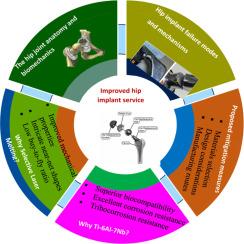The potential of Ti-6Al-7Nb, and design for manufacturing considerations in mitigating failure of hip implants in service
引用次数: 0
Abstract
The hip prosthesis, used to repair or recreate the diseased or damaged hip joint's articulation functionality, greatly influences the outcome of total hip arthroplasty (THA). Currently, the limited lifespan (10–15 years) of hip prostheses presents a serious challenge stemming from poor materials selection, design, as well as manufacturing techniques and this has been amplified further by the rising human life expectancy. Today's hip prostheses are predominantly made of Ti-6Al-4V alloy, which frequently fail owing to wear, modulus mismatch, corrosion, and poor osseointegration. To prolong hip implants’ useful life within the body system, it is crucial to comprehend human hip anatomy and biomechanics, investigate the modes and mechanisms of prosthesis failure, and identify mitigation measures pertaining to materials selection, prosthesis design, and production processes. From this point of view, this article firstly explores the intricate hip joint's structural anatomy in the context of biomechanics principles that influence joint movement and weight bearing. Then, hip implant failure modes and mechanisms are discussed and lastly, the failure mitigation measures are proposed. From this review, Ti-6Al-7Nb known for its excellent corrosion resistance and superior biocompatibility is considered a promising substitute for the mostly used cytotoxic Ti-6Al-4V, functionally graded porosity design mimicking the human bone to enhance mechanical and biomedical properties, more precisely osseointegration and stress shielding, and utilization of the selective laser melting technique capable of fabricating Ti-6Al-7Nb components with intricate shapes and high geometrical accuracy can play a significant role in preventing current hip implant failures.

钛-6Al-7Nb在减轻髋关节植入物在使用中出现故障方面的潜力和制造设计考虑因素
髋关节假体用于修复或重建病变或受损髋关节的关节功能,对全髋关节置换术(THA)的效果有很大影响。目前,由于材料选择、设计和制造技术不佳,髋关节假体的使用寿命有限(10-15 年),这是一个严峻的挑战。如今的髋关节假体主要由 Ti-6Al-4V 合金制成,经常会因磨损、模量不匹配、腐蚀和骨结合不良而失效。为了延长髋关节假体在人体系统中的使用寿命,了解人体髋关节解剖和生物力学、研究假体失效的模式和机制以及确定与材料选择、假体设计和生产工艺有关的缓解措施至关重要。从这个角度出发,本文首先结合影响关节运动和负重的生物力学原理,探讨了复杂的髋关节结构解剖。然后,讨论了髋关节植入物的失效模式和机制,最后提出了失效缓解措施。综上所述,Ti-6Al-7Nb 以其卓越的耐腐蚀性和良好的生物相容性而闻名,被认为是一种很有前途的替代品,可替代目前使用最多的具有细胞毒性的 Ti-6Al-4V;模仿人体骨骼的功能分级孔隙设计可增强机械和生物医学特性,更精确地实现骨结合和应力屏蔽;利用选择性激光熔化技术可制造出具有复杂形状和高几何精度的 Ti-6Al-7Nb 部件,在防止目前的髋关节植入物失效方面可发挥重要作用。
本文章由计算机程序翻译,如有差异,请以英文原文为准。
求助全文
约1分钟内获得全文
求助全文
来源期刊

Biomedical engineering advances
Bioengineering, Biomedical Engineering
自引率
0.00%
发文量
0
审稿时长
59 days
 求助内容:
求助内容: 应助结果提醒方式:
应助结果提醒方式:


